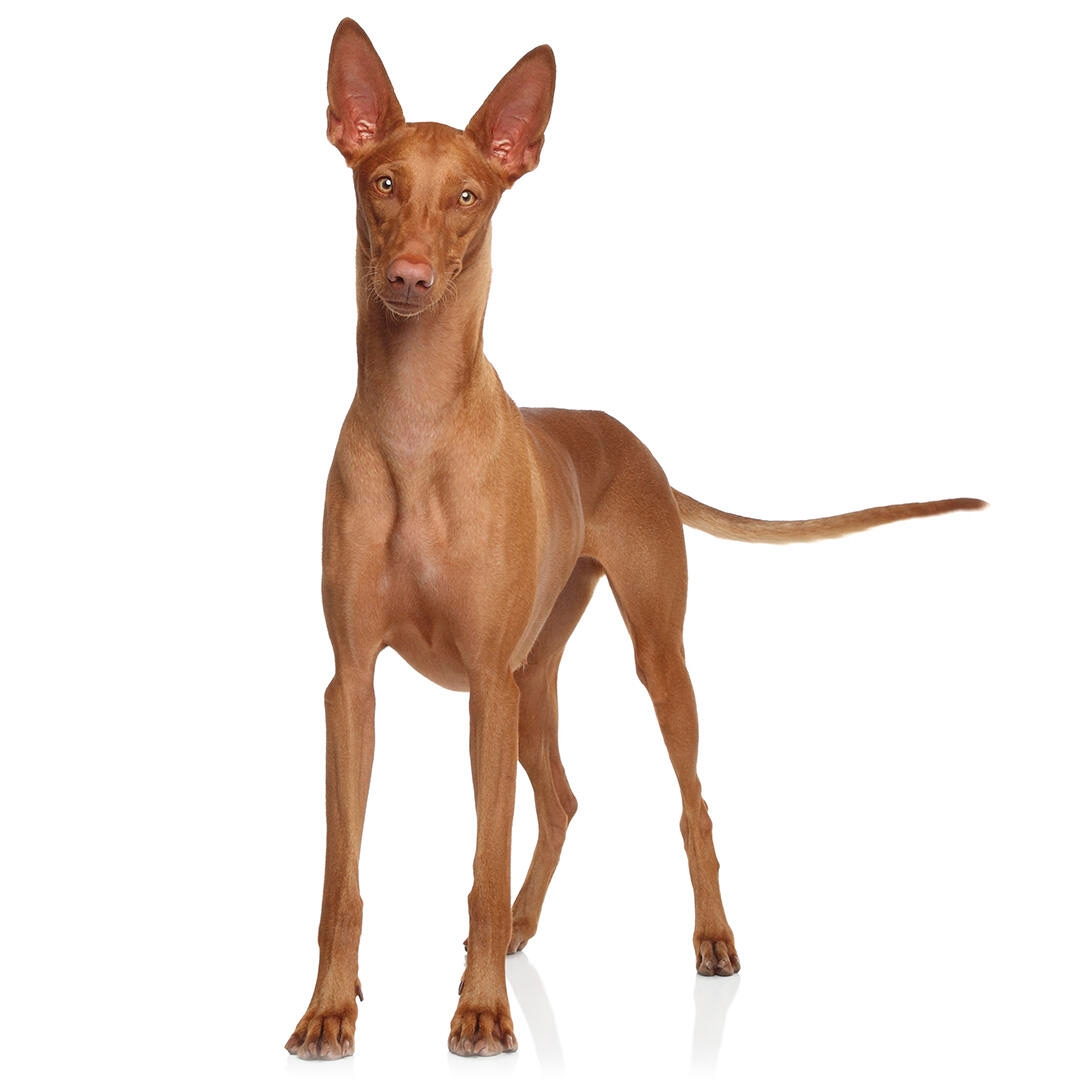
| Family-friendly: | 5/5 |
| Exercise needs: | 4/5 |
| Easy to train: | 3/5 |
| Tolerates being alone: | 2/5 |
| Likes other pets: | 4/5 |
| Energy level: | 2/5 |
| Grooming needs: | 3/5 |
| Shedding: | 2/5 |
The Pharoah Hound can suffer from:
- Patellar luxation
Priority Kennel Club health schemes and testing:
None but there are several recommended schemes that the Kennel Club recommends which can be found here.
This is a sighthound, which means a degree of independent thought is to be expected, but also strong loyalty to family and close friends. The desire to hunt is strong, and the Pharaoh Hound has the staying power and stamina of the long-distance runner as well as the short-term speed of the sprinter. Care must be taken around cats, other small furry animals and livestock.
Unlike many sighthounds, the Pharaoh Hound is quite vocal at times and is also very sociable, enjoying the company of other humans and dogs.
| Family-friendly: | 5/5 |
| Exercise needs: | 4/5 |
| Easy to train: | 3/5 |
| Tolerates being alone: | 2/5 |
| Likes other pets: | 4/5 |
| Energy level: | 2/5 |
| Grooming needs: | 3/5 |
| Shedding: | 2/5 |
Well known in Malta and Gozo for centuries as a farmer’s dog, the Pharaoh Hound was originally known as the Maltese Rabbit Dog. In an attempt to give this dog a more noble title, the enthusiasts of the breed in the 1960s renamed the dog, noting that the Pharaoh Hound closely resembled depictions of houndlike dogs in the wall paintings and carvings of ancient Egypt.
Whilst there is no hard evidence that there is a genetic link, it is likely that Phoenician traders visited the Maltese Islands in ancient times, and there are a number of similar, true breeding types known in the Mediterranean region. Unusual and beautiful dogs have often been traded and gifted between nations and those that perform a useful function such as hunting would be highly prized, making this link quite possible.
This striking red sighthound requires an owner with sighthound experience, who understands how to engage that hunting-dog mind, and channel it into appropriate activity. Ideal owners will have had previous sighthounds, will have a very secure and sizeable garden, and won’t be expecting instantaneous (or even much!) obedience. You’ll also need to enjoy long walks and have access to secure off-lead fields, plus the ability to train a reasonable level of recall to keep this hound safe and satisfied. And an accessible sofa.
The Pharaoh Hound is an excellent athlete, enjoying sprinting, longer distance running and very capable of jumping reasonable heights. Two or more hours a day of exercise is required, and varied exercise types and a variety of routes will be needed to meet their mental exercise needs.
Pharaoh Hounds can hunt by scent as well as sight, and once on the trail of quarry they will not stop!
This is a dog not well equipped to cope with cold or wet, so a coat is necessary for slower walks or to put on before and after faster exercise.
Easily accommodated in any size of home, the Pharaoh Hound requires a decently sized garden with secure 6ft plus fencing. Access to a variety of walks is a must, including secure space to run. Given their vocal nature and desire to alert to any interesting sound, plus incredible hearing, they may not be suited to a busy town or city home with close neighbours.
Your dog's diet needs to have the right balance of all the main nutrient groups including a constant supply of fresh water. It's important to conduct regular body condition scores to ensure you keep your dog in ideal shape and remember to feed them at least twice daily and in accordance with the feeding guidelines of their particular food.
The Pharaoh Hound is easy to groom. They can be groomed using a rubber grooming mitt, which will remove the loose and dead hairs.
The Pharaoh Hound will really enjoy training, and early training to ignore livestock, behave well around cats and other small furries, and of course building a solid recall is vital, although shouldn’t be relied upon!
Pharaohs can do well in a variety of canine sports and competition including Cani-X, agility, obedience, heelwork to music and more.
This is a great breed for the active owner who wishes to take up a dog related sport or hobby and enjoys training. The Pharaoh Hound is no couch potato, and if left bored will invent their own fun!
The Pharaoh Hound does require quite a bit of time for training and exercise and are slow to mature into sensible adult dogs. This may not fit well in a home with very young children and a lack of time. With older children or teenagers who can be involved in training and dog sports, or who enjoy long walks or running, they should do very well.
While many dogs are traditionally thought of as being good with children, all dogs and children need to be taught to get on with and respect each other, and be safe together. Even so, dogs and young children should never be left alone together and adults should supervise all interactions between them.